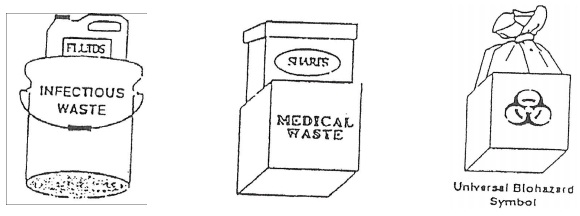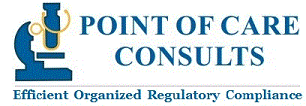Disposal of all infectious waste shall be in accordance with Federal, State and local regulations (outside of N.J. N.Y, Pennsylvania and Florida, you are responsible for getting information from your state and/local DEP).
All infectious waste shall be placed in closable, leak-proof containers or bags that are color-coded, labeled or tagged. If is likely that outside contamination of the container or bag will occur, a second leak-proof container or bag must be placed over the outside of the first container.
ALL medical waste containers will be labeled with the generators name, address and license number/ID number (if applicable).
Disposable syringes, needles, scalpel blades and other sharp items shall be placed in puncture resistant containers for disposal. Container must be properly labeled. Containers will not be filled more than 213 full.
Puncture-resistant sharps containers shall be easily accessible to workers and located in areas where they are commonly used.
Lab specimens of body fluids shall be transported in a container that will prevent leaking and disposed of in accordance with regulatory requirements.
List any additional policies here (eg. transport, segregation):
___________________________________________________________
WASTE DISPOSAL - FACILITY POLICY
Facility waste is segregated at the point of origin into categories that include but are not limited to:
1. Recycled waste (e.g., paper, aluminum, glass) Employees are encouraged to recycle in appropriate containers, which are located in the following area: _____________________________.This facility re cycles the following items (1) _________________________ (2)______________________ (3)______________________Recycled items are collected by ___________________________________ on a (daily, weekly, monthly) basis.
2. Regular Trash Regular trash is waste that poses no health or environmental risk. It is disposed of
through routine waste facilities/companies in appropriate containers. The following company or town/city picks up this waste:
___________________________________________________
3. Infectious / biohazardous “red bag” waste All infectious/biohazard waste shall be placed in closable, leak-proof containers or bags that are color-coded, labeled or tagged. All red bags will be labeled with the generators name, address and ID number (if applicable). Infectiousbiohazard waste in the state of________________________________ and the city of________________________ must be handled appropriately, according to Federal, State, and local laws. Infectious waste must be picked up by a licensed medical waste company and then either incinerated, autoclaved, ground or decontami nated before disposal in a sanitary landfill. Bulk blood, suction fluids, excretions, and secretions may be carefully poured down a drain if connected to a
sanitary sewer where permitted. Sanitary sewers may also be used to dispose of other infectious waste capable of being ground and flushed into the sewer, where permitted. Biohazard containers are kept upright throughout use and are routinely checked by __________________________________________________ biohazard red bag waste is then placed in and then removed/stored when two thirds full. All leak-proof biohazard containers and stored in ____________________________It is then disposed of by (company) ______________________________________________(frequency) _______________
4. Needles/sharps
Disposable syringes, needles, scalpel blades and other sharp items shall be placed in puncture resistant “sharps” containers for disposal. Containers will not be filled more than 2/3 full. All containers will be labeled with the generators name, address and ID number (if applicable). Puncture resistant sharps containers shall be easilyaccessible to workers and located in areas where they are commonly used. All sharps and glassware are disposed of immediately (or as soon as possible) in containers that are closable, puncture-resistant, leak-proof on the sides and bottom, and appropriately labeled with a biohazard label. Location of sharps containers:
___________________________ ___________________________
___________________________ ___________________________
___________________________ ___________________________
5. Chemical Waste
Chemical waste (e.g. bulk liquid chemical, chemotherapy) will be disposed of according to local and federal regulations. Write policy here:
___________________________________________________________
___________________________________________________________
___________________________________________________________
___________________________________________________________
6. Record keeping
The following records of waste disposal will be kept for a minimum of 3 years:
State license/ID number (if applicable), medical waste transporters license number, generator pick up (tracking) form and waste disposal/destruction confirmation form.
PROCEDURE FOR PREPARING MEDICAL WASTE
Medical waste generated by this facility must be properly packaged, labeled, and marked before being transported to an off-site facility for treatment or disposal.
PROCEDURES
1. Medical waste generated by this facility will be placed in a container or combination of containers that are rigid and leak resistant, impervious to moisture, strong enough to prevent tearing or bursting under normal handling, and securely sealed.
2. Sharps (e.g., needles, razor blades, broken glass, syringes, lancets, scalpel blades, etc.) will be packaged in a rigid container resistant to punctures.
3. Fluids will be poured into a container resistant to breaking and equipped with a tightly fitting lid or stopper.
4. A water-resistant label will be affixed to all containers or packages of untreated medical wastes.
5. When there is inner and outer packaging, or containers, each container (inside and outside) will be labeled “Infectious Waste” or “Medical Waste” or display the universal Biohazard Symbol as illustrated below:

6. Red plastic bags, when used as inner packaging for untreated waste, need no labels. However, the outer packaging or container will be identified by the proper label or symbol.
7. Before shipment, all packaging-inner and outer-will be marked with indelible ink or with a water resistant identification tag. Each inner container, if used, will show the name and address of this facility (or identifying numbers).
* A training guide for packaging medical waste follows this page
WHAT IS OVER-CLASSIFIED MEDICAL WASTE?
OSHA lists what is classified as regulated waste (see page 6-3). If the facility generates a waste that is potentially infectious but does not fall into a regulated category the facility must decide how to handle this waste. Infectious or contaminated waste that does not fall into the regulated category is called over classified waste”. There are two disposal options for this waste. It is the responsibility of the person in charge of medical waste to check with local, county and state regulations before making the decision on how to dispose of questionable materials. The follow serves as a guideline:
Option 1: If put in a red bag, the bag must be picked up by your medical waste carrier. If your State charges the facility by the pound for a medical waste licence, you can keep the weight of this waste separate since it is not technically regulated waste. This weight can be deducted from the total weight picked up by the medical waste disposal company so it would not be counted toward the medical waste licencing fee.
Option 2: If the town and county has no regulations concerning disposal of nonregulated medical waste, you can put this waste in a regular (not red) trash bag. This trash must be segregated in the facility and MAY NOT be mixed with “clean” trash. If this option is used - the trash can (not bag) this waste is stored in must have a lid and the can or lid must be labeled with a bio-hazard or a infectious waste label. The reason the can must be marked is to protect the employees and warn other people that they should not put their hand into this waste receptacle and wear gloves when tying up bag for removal. There are two disposal options:
(1) the bag can be put out with the regular trash
(2) the bag can be put in the biohazard waste storage box, keeping track of the weight if it effects the cost of the medical waste licencing fee.
It is your responsibility to make sure this option is acceptable before putting it out
Option 2: to your regular trash for pick up.
If you are un-sure whether an item is “regulated” or “over-classified” call your State department of medical waste and ASK!
CONSIDERATIONS FOR DRAIN DISPOSAL OF CHEMICALS
1. Certain chemicals are permissible for drain disposal.
2. Local sanitary sewer district will be contacted to determine what is and what is not acceptable.
3. Facility’s waste water flow rate should be calculated to document any chemical concentration at time of entry into sanitary sewer system.
4. Drain system should eventually flow to waste water treatment plant.
5. Only those chemicals reasonably soluble in water are suitable for drain disposal. A compound is considered water soluble if it dissolves to the extent of at least 3%. These compounds will be flushed with at least 100 volumes of excess water.
Some exceptions should be noted:
A. Organics with boiling points less than 50 C.
B. Hydrocarbons, halogenated hydrocarbons, nitro compounds, mercaptans, and most oxygenated compounds that contain more than five carbon atoms (E.g.: Freon).
C. Organics that are explosives such as azides and peroxides.
Check with your State DEP, water company or medical hazardous waste disposal company if you are unsure of regulations for drain disposal for certain chemical or biohazardous liquids.
 Hours:
Hours: 

